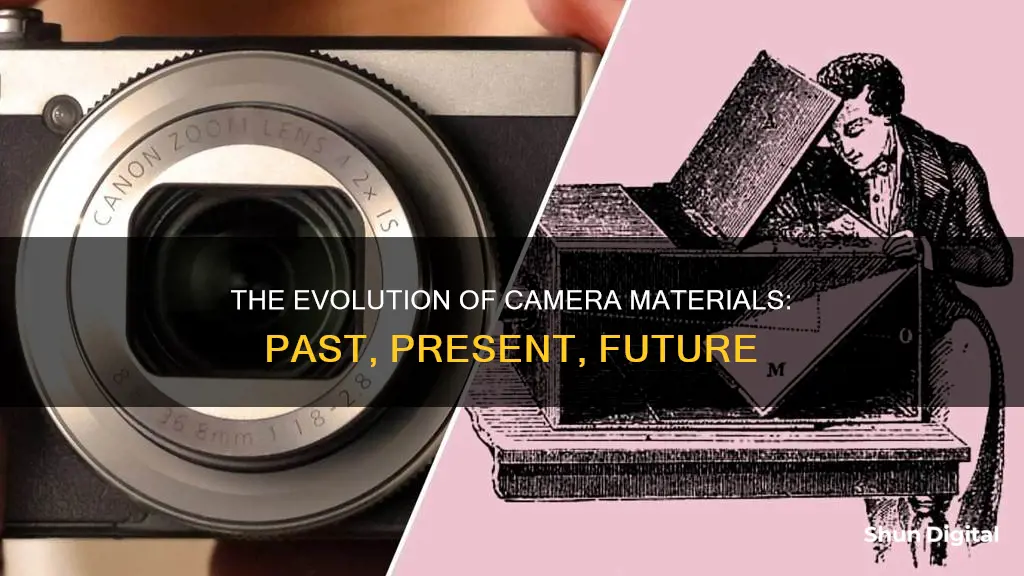
Cameras are made from a variety of materials, including metal, plastic, wood, leather, and glass. The specific materials used depend on the type of camera, with digital cameras requiring silicon-based chips and film cameras using photographic emulsions containing silver. The camera body, or chassis, is often made from plastic or a composite material, while the lens is typically made of glass or plastic.
| Characteristics | Values |
|---|---|
| Camera Body | Metal, Plastic, Wood, Leather |
| Lens | Glass, Quartz Glass, Fluorite, Acrylic (Plexiglass), Germanium, Meteoritic Glass |
| Lens Coating | Anti-flare, Anti-reflection, UV |
What You'll Learn
- Camera bodies can be made from plastic, metal, wood, or a composite material
- Camera lenses are typically made from glass
- Other lens materials include quartz glass, fluorite, and plastics
- Digital cameras have silicon-based chips in their CCD light detectors
- Film cameras use photographic emulsions containing silver to capture images

Camera bodies can be made from plastic, metal, wood, or a composite material
Camera bodies can be made from a variety of materials, including plastic, metal, wood, or composite materials. Each material offers unique advantages and considerations in the construction of camera bodies, contributing to factors such as durability, weight, and aesthetics.
Plastic camera bodies are commonly found in modern cameras due to their ease and economy of manufacturing. Plastic is mouldable, allowing designers to create ergonomic shapes that feel warmer, softer, and lighter in the user's hands. This flexibility in design also breaks away from the traditional angular box-like look of early cameras.
Metal camera bodies, such as those made from die-cast metal alloys, were more prevalent in older cameras. Metal provides durability and resistance to weather conditions. For instance, Canon's EOS camera features a hybrid chassis made from die-cast aluminium, surrounded by reinforced polycarbonate, resulting in exceptional strength and weather resistance.
Wooden camera bodies, though less common, have been explored by companies like Olympus. In 2006, Olympus unveiled a camera body made from compressed wood, utilising a three-dimensional compression moulding process. This "new wood" was harder than engineering plastics and enhanced the aesthetic value and pleasure of ownership.
Composite materials, such as carbon fibre reinforced thermoplastics, have also been introduced in camera construction. For example, Nikon employed a carbon-fibre reinforced plastic front plate in its DSLR camera, the D750, offering both weight and cost savings.
The Evolution of Computer Cameras: How Are They Made?
You may want to see also

Camera lenses are typically made from glass
When light waves enter a piece of glass at an angle, one part of the wave will reach the glass before another and so will start slowing down first. This has the effect of causing the light to bend in one direction. It bends again when it exits the glass because parts of the light wave enter the air and speed up before other parts of the wave. In a standard converging, or convex lens, one or both sides of the glass curve out. This means that rays of light passing through will bend toward the centre of the lens on entry. In a double convex lens, such as a magnifying glass, the light will bend when it exits as well as when it enters.
This effectively reverses the path of light from an object. A light source, such as a candle, emits light in all directions. The rays of light all start at the same point and then constantly diverge. A converging lens takes those rays and redirects them so they are all converging back to one point. At the point where the rays converge, you get a real image of the candle.
A camera lens may be made from a number of elements, from one to over 20 in the more complex zooms. These elements may themselves comprise a group of lenses cemented together. The front element is critical to the performance of the whole assembly. In all modern lenses, the surface is coated to reduce abrasion, flare, and surface reflectance, and to adjust colour balance.
Other materials used to make camera lenses include quartz glass, fluorite, plastics like acrylic (plexiglass), and even germanium and meteoritic glass. Plastics allow the manufacturing of strongly aspherical lens elements which are difficult or impossible to manufacture in glass, and which simplify or improve lens manufacturing and performance. However, plastics are not used for the outermost elements of all but the cheapest lenses as they scratch easily.
Capturing Pets: Best Camera Modes for Perfect Portraits
You may want to see also

Other lens materials include quartz glass, fluorite, and plastics
Camera lenses are typically made of glass, but other materials can also be used, such as quartz glass, fluorite, plastics like acrylic (Plexiglass), and even germanium and meteoritic glass. These alternative materials offer unique advantages and are sometimes used in high-performance lenses.
Plastics, for instance, enable the manufacturing of strongly aspherical lens elements that are challenging or impossible to produce in glass. This simplifies or improves lens manufacturing and performance. However, plastics are generally not used for the outermost elements of lenses due to their susceptibility to scratching. Molded plastic lenses are often found in cheap disposable cameras, and manufacturers of quality optics may use euphemisms such as "optical resin" to describe their plastic lenses. Nonetheless, many modern, high-performance lenses from popular manufacturers incorporate molded or hybrid aspherical elements, debunking the notion that all plastic lenses are of low photographic quality.
Quartz glass is another alternative lens material. While less common than traditional glass, it offers distinct optical properties that make it suitable for certain lens designs. Fluorite, a form of calcium fluoride crystal, is also used in lens construction due to its unique optical characteristics. Germanium and meteoritic glass are more exotic options, chosen for their ability to transmit light in specific ways.
Each of these materials brings distinct advantages and optical properties to the table, contributing to the diverse array of lenses available for various photographic applications.
The Evolution of Smartphone Cameras: How Are They Made?
You may want to see also

Digital cameras have silicon-based chips in their CCD light detectors
The CCD light detectors are made of a silicon surface onto which an integrated circuit is etched. This etched surface forms an array of pixels which collect incoming photons, generating photoelectrons. These photoelectrons have a negative charge, so they can be shifted along the sensor to readout registers where they can be amplified and converted into digital grey levels. This process is called charge transfer.
The CCD light detectors are used to convert photons into electron charges at the semiconductor-oxide interface. The CCD is then used to read out these charges. The basic building blocks of a CCD are p-doped metal-oxide-semiconductor (MOS) capacitors. The CCD image sensors can be implemented in several different architectures, including full-frame, frame-transfer, and interline.
The full-frame CCD has the advantage of having almost 100% of its surface area being photosensitive, with no dead space between pixels. However, it requires an electromechanical shutter to protect the imaging surface from incident light during readout. The frame-transfer CCD can operate at faster frame rates than the full-frame device as exposure and readout can occur simultaneously. The interline-transfer CCD design has columns of active imaging pixels and masked storage-transfer pixels that alternate over the entire parallel register array. This allows for very short integration periods and electronic control of exposure intervals.
Point-and-Shoot Cameras: Can They Shoot RAW?
You may want to see also

Film cameras use photographic emulsions containing silver to capture images
When the exposed film is placed in a developing agent, the areas surrounding the sensitivity specks are converted into silver, and the exposed areas start to turn black, developing the image. The process of converting the latent image into a visible photograph is known as "developing." The developers are chemical agents that reduce silver halides to silver, giving them the name "developers."
The film is then placed in another agent called a "fixer," which dissolves the silver halides, leaving only the black silver grains. This process is called "fixing." The resulting image is a negative, where the areas exposed to light appear as shades of black. When light is shone through the negative onto photographic paper, the blackened areas show up as lighter shades, creating a positive image.
The type and quantity of silver used in the emulsion affect the image quality. While more silver results in less grain, it also increases turbidity and reduces sharpness. Thus, achieving the right balance of elements is crucial in the emulsion's production. The way the emulsion is coated and the gelatin used also play significant roles in the final image quality.
The three main silver halide compounds used in photography are silver iodide, silver chloride, and silver bromate, with silver chloride and silver bromate being more sensitive to light. Silver nitrate, the precursor of the halides, is relatively stable, easily dissolves in various solvents, and is the least expensive salt of silver.
Outdoor Game Motion Cameras: How Long Do Batteries Really Last?
You may want to see also
Frequently asked questions
Cameras are typically made of aluminium, steel, plastic, and glass lenses.
Camera lenses are typically made of glass, owing to its good optical properties and resistance to scratching. However, other materials such as quartz glass, fluorite, plastics like acrylic, and even germanium and meteoritic glass are also used.
Camera bodies are usually made of plastic or a composite material. Older cameras are made of die-cast metal alloy.
Digital cameras have silicon-based chips in their CCD (charged-couple device) light detectors.







